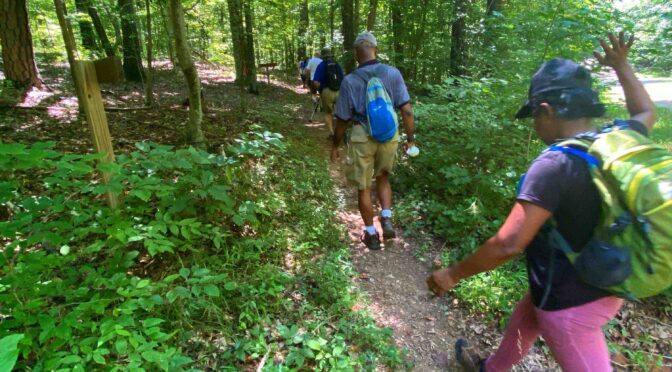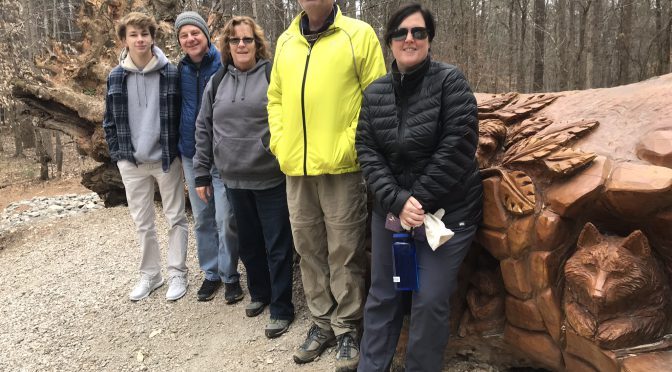
One a year we feel compelled to reiterate the rules of proper trail etiquette. This year, we both reiterate and update the rules to reflect the brave new world of pandemic hiking.
A few basic civilities to keep in mind on the trail:
- Yielding. Until this year, the simple rule of yielding when encountering other hikers on the trail, especially a narrow trail, was that the downhill hiker yields to the uphill hiker. That is, the person hiking downhill should step aside and let the uphill hiker have the trail. To that, we add these coronavirus addendums: 1. The downhill hiker should not just step to the side of the trail, but should step at least 10 feet off the trail (when possible); and, 2. Both hikers should also cover their faces (a bandana or a Buff can serve double duty here.
- Yielding on multiuse trails. On trails open to horses and mountain bikers as well as hikers, horses always have the right-of-way. When mountain bikers and hikers meet, mountain bikers yield to hikers.
- Passing. Several years agoI was last in our group of eight when I heard footsteps rapidly approach from behind. I waited for an acknowledgement — a request to pass or at the very least, a throat clearing — as the footsteps neared. None came, so I stepped off the trail to my right; a young runner passed, not breaking stride, not acknowledging my action. When she caught up to the next hiker in our group, she simply stopped and walked tight on our hiker’s heels. Our hiker, sensing someone behind her, turned, stepped aside and said, “You’re welcome to pass.” The runner did, with barely a grunt of thanks. It’s not impolite to pass a slower party on the trail; just announce your intentions, ideally with a brief and robust, “On your left,” issued 15 to 20 feet before the passing zone.
- Thanks! Oh yes, and when someone does yield, please acknowledge their gesture with a “Thanks!”, a cheerful one.
- Stopping? Step to the side of the trail. If you stop to take a drink, check the map, or eat some gorp, step off the trail.
- Be aware of your surroundings. Good trail etiquette comes down to being aware of your surroundings and remembering that the quiet, the fresh air and the freedom that the trail offers you is why others are here as well. That said, two specifics that, alas, do need to be said:
- Do not smoke on the trail. On a group hike a while back, a member of our party stuck her nose in the air, sniffed and said, “Is that cigar smoke?” Surely not, I said. It was more likely the rotting carcass of a woodland creature who had met its demise. Yet 10 minutes up the trail, off to the side, sat a 20s-ish fellow with a stogie. True, most trailhead kiosks don’t specifically address smoking — perhaps because common sense would dictate that the trail is not a suitable venue.
- No portable speakers. On the same hike that we encountered the smoker, we were shortly after treated to a tinny, scratchy, cacophony of quiet-shattering chaos, emanating from a portable speaker clipped to the water bottle belt of a young runner. If you want to listen to adrenalin-pumping music rather than soothing woodland noises, wear earbuds.
- Leash your dog. Most places where we hike — state parks, municipal parks, national parks, nature preserves — require that your dog be leashed, and many require that they be on a six-foot leash, not a 16-foot retractable tether that can wreak havoc for unsuspecting hikers, cyclists, equestrians. The reasons for leashing are many. At the top of the list is that some hikers aren’t comfortable with dogs, especially ones that come bounding up to them in the wild, friendly though they may be. There’s also the matter of protecting the dog from—squirrel! Fido’s primal olfactory instincts kick in and he may never be seen again.
- Pick up your pup’s poop. Everywhere you hike, this is the rule. But more than being a rule, it’s just common courtesy to your fellow hikers. Hopefully, we don’t need to elaborate.
- … And take the poop bag with you. Actually, we do need to elaborate: After you have bagged said poop, take it with you, do not leave it packaged by the side of the trail. We’ve heard more than one hiker say, “I’ll pick it up on my way out.” If this is the explanation behind every trailside receptacle of refuse we spot, then somewhere deep in the woods are hundreds of hikers and their dogs wandering in search of the “way out.”
- Seek permission before petting. I know: every dog looks like it wants to be petted. Even so, ask permission before taking a knee and diving into a rousing round of, “Who’s-a-good-dog?” with a dog you don’t know — and, perhaps more importantly, doesn’t know you.
- Know your dog. Not all dogs like other dogs. Or people. If your dog has an iffy history with other critters, avoid heavily trafficked trails at busy times.
Observing a few simple, common sense rules of trail etiquette will come in especially handy as we, eventually, head into fall and cooler weather. Be considerate, and have a great hike!



